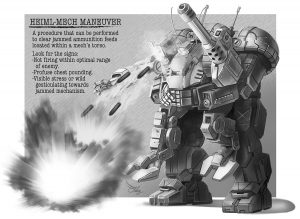Woodsman
Sarna News

- Bad ‘Mechs - Sentinel
- HEXTECH Review - Wave 3 Brings More Urban Options To Your Battlefield
- Your BattleTech News Round-Up For March, 2024
- Crashing 'Mechs With Jennifer Brozek, Author Of The Rogue Academy Trilogy
- Getting The Word Out With Rem Alternis, Catalyst Community & Marketing Director
- Read more →

| |
| Woodsman | |
|---|---|
| Production information | |
| Manufacturer | Wolf Clan Site 2 |
| Production Year | 2865[1] |
| Model | Prime |
| Class | Heavy |
| Technical specifications | |
| Mass | 75 tons |
| Chassis | WOD-1 Endo Steel |
| Armor | Standard |
| Engine | Wolf 300 |
| Communications System | WolfCom 3-4 |
| Targeting Tracking System | CW3 |
| Heat Sinks | 12 Double Heat Sinks |
| Speed | 64 km/h (86 km/h with MASC) |
| Jump Jets | Pod mounted |
| Armament |
Primary Configuration
|
| BV (2.0) | 2,623[2] |
Contents
Description
The first heavy OmniMech developed by Clan Wolf, the Woodsman was one of the most heavily tested weapons ever produced by the clan. Every last detail was considered and problems were eliminated before production began. This resulted in a chassis that would not only function well in the Clan's front line forces for nearly a century, but also inspire the Timber Wolf, Gargoyle, and Naga OmniMechs.[2][3][4][5][6]
Heavy armor provided excellent protection, while a standard fusion engine improved longevity on the battlefield. The light Endo Steel chassis allowed the Woodsman to devote 27 tons to pod space, allowing many mission specific loadouts and prototype weapon configurations. The permanently installed MASC system allowed a pilot to briefly exceed 80 km/h to either withdraw or capitalize on breaches in enemy ranks. Though it served the Wolf Clan well, it was eventually surpassed by newer designs. The Woodsman was relegated to second-line units, and then eventually phased out of service completely. There are some rumors that a few Dark Caste bandits may have a Woodsman, but these reports remain unconfirmed.
Weapons and Equipment
The primary Woodsman configuration would be mirrored in the default Timber Wolf weapon load. Each arm carried an ER Large Laser, ER Medium Laser, and LRM-15. To provide anti-infantry work, a pair of Machine Guns was mounted in the center torso. Five additional pod mounted double heat sinks brought the total up to seventeen, allowing the Woodsman to fire most of its weaponry without worrying about heat overloads.
The Woodsman was so versatile that it was often used by Wolf scientists to test new weapons and weapon configurations. The Nagas dual Arrow IV launcher configuration, for example, was tested on the Woodsman chassis.
Alternate Configurations
- Alternate Configuration A
- The most common alternate configuration in the Woodsman's long career mounted two ER PPCs, two Medium Pulse Lasers, with a Large Pulse Laser and ER Small Laser for backup. It keeps the same number of double heat sinks as the primary configuration, but relocates them across the torso. BV (2.0) = 2,741[7]
Related OmniMechs
- Timber Wolf - The Timber Wolf was one of three OmniMech chasses designed replacements for the Woodsman OmniMech. The Timber Wolf was meant to be a direct upgrade of the original, while the Gargoyle and the Naga OmniMechs were designed with more specialized roles in mind.[2][5]
- Gargoyle - By increasing both the size and engine of the Woodsman chassis, Clan Wolf engineers were able to create the Gargoyle Clan OmniMech. The Gargoyle's armor protection and top speeds are virtually identical to that of the Woodsman without requiring a temperamental MASC system. The drawback to removing the MASC was a 6-ton reduction in pod space.[3][2][6]
- Naga - In regards to appearance, the Naga is strikingly reminiscent to the Woodsman chassis. However, the role of the Naga is very different from the very flexible Woodsman; the Naga was adapted into a dedicated fire support/artillery unit, with fixed Arrow IV systems in each side torso. This leaves only enough pod space for pilots to customize the Naga's secondary weapons, ammo load, or point defense.[2][3][4]
References
- ↑ Era Digest: Golden Century, p. 21, "Random Assignment Tables"
- ↑ 2.0 2.1 2.2 2.3 2.4 Era Digest: Golden Century, p. 25
- ↑ 3.0 3.1 3.2 Technical Readout: 3055, p. 140
- ↑ 4.0 4.1 Technical Readout: 3055 Upgrade, p. 92
- ↑ 5.0 5.1 Technical Readout: 3050 Upgrade, p. 136
- ↑ 6.0 6.1 Technical Readout: 3050 Upgrade, p. 138
- ↑ Era Digest: Golden Century, p. 34

